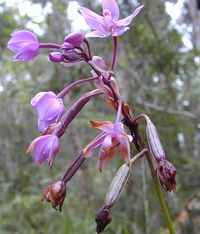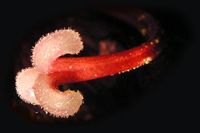متاع
المتاع Pistillate أو Gynoecium هو عضو التأنيث في الزهرة وهو مؤلف خباء واحد أو أكثر.
أنواع المتاع


| Gynoecium composition | مصطلح الكربلة | مصطلح الخباء | الأمثلة |
|---|---|---|---|
| خباء مفرد | Monocarpous, or unicarpellate gynoecium | A pistil (simple) | أڤوكادو (Persea sp.), most legumes (Fabaceae) |
| خباءات متعددة ومميزة (غير ملتحمة) | Apocarpous* gynoecium | Pistils (simple) | Strawberry (Fragaria sp.), buttercup (Ranunculus sp.) |
| Multiple connate
(fused) carpels |
Syncarpous gynoecium | A pistil (compound) | Tulip (Tulipa sp.), most flowers |
أشكال الخباء
وضع الخباء

Basal angiosperm groups tend to have carpels arranged spirally around a conical or dome-shaped receptacle. In later diverging lineages, carpels tend to be in whorls.
The relationship of the other flower parts to the gynoecium can be an important systematic and taxonomic character. The ovary of the gynoecium can be above the attachment of petals and sepals to the receptacle. In this case the ovary is called superior. This corresponds to a the term hypogynous, used to describe a flower with a fully superior ovary.
In some flowers with superior ovaries, (examples include many members of the rose family, Rosaceae) the base of the stamens, petals and sepals are fused into a floral tube or hypanthium. In these flowers, the ovary can be free of or partially adnate (fused) to the hypanthium, but remains at least partially superior. These flower are called perigynous.
In some flowers, the ovary is completely fused to the hypanthium. Only the style and stigma project above the sepals, petals, and stamens, which appear to attach to the top of the ovary. This sort of ovary is called inferior ovary, and the flower is said to be epigynous. Examples of plant families with inferior ovaries include the orchids Orchidaceae, sunflower Asteraceae and the evening primrose Onagraceae.
الهامش
- Esau, K. 1965. Plant Anatomy, 2nd Edition. John Wiley & Sons. 767 pp.


